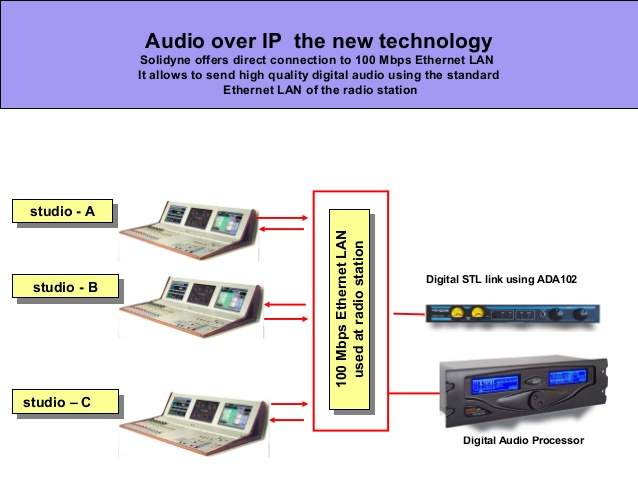Streaming audio over IP (AoIP) networks is being increasingly used by broadcasting companies, among others, to provide high-quality audio feeds over distance across an IP network such as the Internet. The application is also known as audio contribution over IP (ACIP) in reference to the programming contributions made by field reporters and remote events. Audio quality and latency are key issues for contribution links.
In the past these links have made use of ISDN services but these are becoming increasingly difficult or expensive to obtain in some parts of Europe and are being phased out in others. Many proprietary systems came into existence for transporting high-quality audio over IP based on TCP, UDP or RTP. An interoperable standard for audio over IP using RTP now exists.
Within a single building or music venue, audio over Ethernet (AoE) is more likely to be used instead, avoiding audio data compression and IP encapsulation.
Technology
The European Broadcasting Union (EBU) together with many equipment manufacturers has defined a common framework for audio contribution over IP in order to achieve interoperability between products. The frameworks define RTP as a common protocol and media payload type formats according to IETF definitions. SIP is used as signalling for call setup and control. The recommendation is currently published as EBU Tech 3326-2007.
More advanced audio codecs are capable of sending audio over unmanaged IP networks like the internet using automated jitter buffering, forward error correction and error concealment to minimise latency and maximise packet streaming stability in live broadcast situations over unmanaged IP networks.
Due to the exhaustion of IPv4 IP addresses, IP audio codecs should now also be IPv6 compatible to ensure they are capable of connecting over new Internet infrastructure. IPv6 infrastructure is being widely deployed to deliver a virtually inexhaustible supply of IP addresses. IPv6 addressing makes it much easier for broadcast codecs to connect to each other directly and perform flexible multi-point connections over IP.
Examples of use
The BBC has begun using audio contribution over IP in Scotland as part of the Pacific Quay development in Glasgow. A similar system is being installed in the Regions of England and will be installed in Wales and Northern Ireland. The audio packets are sent using UDP over the BBC’s Layer-3 network. To reduce the chance that the audio is corrupted, quality of service (QoS) is set to ensure that the packets are given priority over other network traffic. The platforms used are the WorldNet Oslo for multiple channel contribution and distribution with the WorldCast Horizon deployed in stereo drop-off locations. The aptX algorithm is used with 24 bit depth and 48 kHz sampling. This is a higher specification than normal CDs, and is used to avoid concatenation effects. There have been problems found in the past when NICAM and MPEG audio paths have been used in sequence in the broadcast chain. The audio heard in the presentation studio has been acceptable, but listeners at home using DAB have complained about artifacts. To avoid this, aptX is used at high bit rates. This is a differential PCM system that does not use psychoacoustic processing. It is able to resynchronise after momentary loss of the IP path without noticeable clicking, and is licensed to most codec manufactures.
Audio over IP is even used for large sport events. More than 1000 Barix IP Audio Codecs have been recently used to network the various venues of the Commonwealth Games hosted in India.
Codecs such as the Tieline i-Mix G3 have been used since 2004 at the Olympic Games for live sports broadcasting. These codecs also have the ability to send audio over wireless IP, i.e. 3G and Wi-Fi, as well as other audio transports like POTS, ISDN, satellite and X.21, and have been used at UEFA and World Cup Soccer tournaments.
Ultra portable audio over IP codecs are also available as a smartphone applications to send high fidelity broadcast quality audio from remote sites to studios. Applications such as Report-IT Live for iPhone can send bidirectional 15 kHz quality audio live with automated jitter buffering, forward error correction and error concealment. They can also send 20 kHz quality audio recordings from the phone to a studio via FTP.
The New Jersey Transit Corporation distributes messages to their customers using audio over IP equipment, and IP audio technology is used in modern train carriages for customer information and messaging now.
Audio over IP is also used in scientific applications, such as the Neumayer Station in Antarctica, where Barix IP Audio encoders digitize and stream the complete audio spectrum captured by hydrophones under water to the Alfred Wegener Institute for Polar and Marine Research in Germany.

